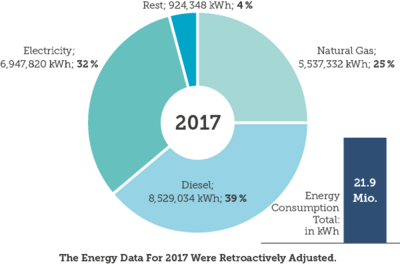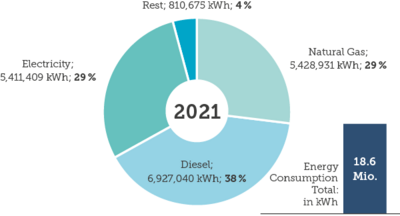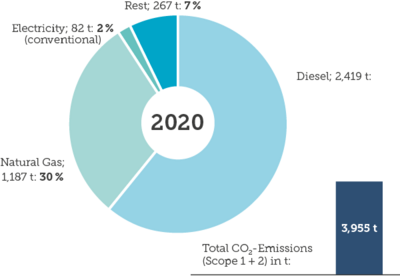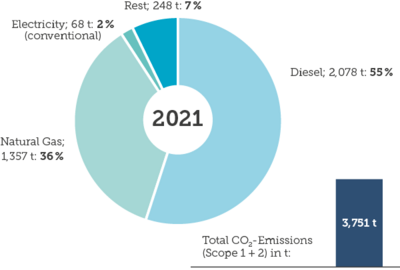Energy Intensity kWh Energy per Metric t of Handled Cargo
Climate & Air
Good Climate
Climate change and the adjustment to its consequences pose one of the biggest challenges for us. As an energy-intensive company, we wish to make an essential contribution towards climate protection. We therefore increasingly support the utilization of renewable energies for the maintenance and the expansion of the ports. We are always striving to seek out energy- saving and lower-emission alternatives to keep our footprint as low as possible. What's good for the climate is good for our company.
We actively apply measures for the protection of the climate. Our business model closely associates energy, greenhouse gas emissions, and air pollutants. In 2017 we decided to reduce our emissions by 2025 by 25% and to significantly lower our energy consumption, for instance, by switching the entire outdoor lighting to 100% LEDs. On the other hand, we have contributed to the climate protection through increased utilization of alternative fuels. During the reporting period, we have already accelerated these projects quite a bit.
For the future, we intend to set ourselves even more ambi- tious goals. In doing so, we want to position ourselves as a trend setter for the energy transition, in a twofold way: As a company, we have set ourselves the goal “Climate Neutrality by 2035” (within scopes 1 and 2). To make this happen, we are creating a road map in 2023/2024 (the so-called Transformation Concept): The other way that we are doing this, is by being a supporter of the energy supply security and of the energy transition. Our ports are crucial hubs for sustainable energy sources of the future, and for providing the suitable heavy-load capable port infrastruc- ture for the installation and expansion of offshore wind turbines in the North Sea.
And now that we find ourselves in this crisis situation, we are substantiating our trend setter role anew: We are the first German port to have made the import of LNG possible. To achieve this, we constructed the first LNG jetty in November of 2022 so that the stationary floating facility there, the so-called FSRU22 Terminal, could go operational in December of 2022. In December of 2023, we will commission another LNG jetty in Stade-Bützfleth, which will be available as a berth for an additional FSRU. Starting in 2027, the FSRU terminal is slated to be replaced by a larger, land-based terminal. This land-based terminal will be able to handle larger amounts of liquefied gas.
This way, with the help of the floating unit, up to 5 billion m3 of gas can be transferred each year. And the land- based units will have an annual throughput capacity of up to 13 billion m3 of gas.
Energy
In order for us to reach our goal of “Climate Neutrality by 2035, we are developing a transformation concept in 2023/2024 for its implementation. It contains a road map with concrete measures for the coming years and it is forward-looking in terms of the innovations that the future will bring. To optimally derive the commensurate goals and measures, we are planning the introduction of a new energy management software in 2023. With it, we will capture our consumption and emissions even more systematically, more automated, and in a safer manner.
Energy Management
The superordinate topic ‘energy’ was placed with our staff department ‘Strategic Corporate Development’. The operational responsibility is in the hands of each indi- vidual branch. During frequent meetings, pertinent topics and projects are discussed and measures are decided. The round table ‘Energy Efficiency’ offers a platform for all employees working on the topic. The coordination of the strategic and operational goals, measures, and parameters for the topics energy and climate protection is overseen by the Sustainability Management within the scope of the Sustainability Strategy.
In 2019, we performed an energy audit pursuant to DIN EN 16247-1 once again. On this basis, we were able to create an energy monitoring system. We have been using it since 2016 to capture any energy-relevant data. The database is the controlling instrument of our energy policy and it simultaneously serves as the base for the energy audit. Aside from the utilized energy sources, the system relates the pertinent energy consumptions to the facilities, buildings, and systems. Through the monitoring, we were able to identify the large energy drivers and to derive commensurate measures. The next energy audit will be performed in 2023.
In general, there are four factors that are crucial for our energy consumption:
- Cargo Handling: The handling quantity and the mate- rial and work deployment needed for it are influencing our energy consumption, for instance through the deployment of equipment and systems.
- System Technology and Control: Technical innova- tions in the existing system technology and for the system control are improving the energy efficiency
- Behavior: Our employees are operating equipment and systems that use a lot of energy. Training, education, instructions, etc. can contribute to a more efficient utilization.
- Environmental Conditions: On the one hand, the weather dictates the operation of heating systems in our warehouses, workshops, and buildings. On the other hand, the number of storm events, for instance, influ- ences the dredge activities necessary for maintaining the proper water depths.
Energy Consumption
Electricity, natural gas, and diesel make up slightly more than 95% of our energy consumption. To make the deployment more environmentally and climate friendly even for these energy sources, we optimize the utilization of traditional energy sources, and, wherever possible, replace them through climate friendly and energy saving alternatives.
Here, one of the ongoing activities lies in the modernization and/or retrofitting of our buildings, for instance by utilizing more energy-efficient heating systems and the replacement of windows and attic insulations. We also improve our land and water vehicle fleet using sustaina- bility aspects through energy-efficient propulsion systems or alternative fuels. One important measure that immedi- ately pays a dividend towards our Sustainability Strategy: The gradual streamlining of the port lighting by deploying smart LED systems.
All told, we were able to reduce our energy consump- tion since the first energy monitoring in 2014 by 20%. Compared to 2017, we were able to save 15%. We have achieved this great success with a plentitude of energy efficiency measures, such as the optimization of processes, the increase of efficiency of our heating systems, of the vehicle fleet, or the lighting system.
In 2021, we were able to decrease our electricity consump- tion compared to 2017 by 22%; and our gasoline consumption by 64%. At the same time, however, the liquefied gas portion in 2021 increased by 50% when compared to 2020. In comparison to 2017, our natural gas consumption has decreased by 2%, and compared to 2020, it increased by 14%. On the one hand, this increase can be traced back to weather conditions, since the winter of 2021 was comparably cold. On the other hand, this can be explained by renovation work and construction sites in 2021 that resulted in an increased consumption of natural gas. All the other energy values in 2021 were reduced.
Climate Protection and Air Pollutants
Maritime shipping - when you compare it by each ton kilometer - produces significantly less CO2 than transport on land. Still, the exhaust fumes from ship's engines impair the environment, since ships traveling outside the SECA and ECA area are largely operated with heavy fuel oil. It contains significantly more sulfur oxides and other pollutants (such as heavy metals, nitric oxides, etc.) than you will find in fuels used in land transport. While mari- time shipping produces 3% of the CO2 emissions globally, 13% of all air pollutants are attributed to it.
The air emissions in the port come from various sources: from the port operators, the maritime shipping industry (such as ship owners and ship operators), and from other companies within the port. Some of the emissions that occur in the port we have only minimal influence, such as emissions from external ships or from the hinterland traffic.
In the future, we intend to largely reduce emissions that are directly influenceable by us. As mentioned earlier, we have set an ambitious goal for ourselves: Climate Neutrality by 2035. We must partition this goal into smaller steps and set some intermediate goals for ourselves. This is, what we intend to achieve in 2023/2024. As always, we will apply our standards in line with the scopes of the Greenhouse Gas Protocol (GHG protocol). In doing so, we put an emphasis on direct (Scope 1) and indirect GHG emissions (Scope 2). The indirect Emissions in the upstream and downstream value chain (Scope 3) will not be captured at first (See image p. 18) Within the current Sustainability Strategy, we have formulated our express goal to reduce our emissions by 2025 (compared to 2017) by 25%. Even as early as 2019, we were able to reach almost half of that goal with a reduction of 11%. In 2021, we were able to achieve a reduction of 21%. Switching largely over to eco power (eco electricity), the increased use of lique- fied gas, resulting in less use of diesel fuel, have certainly played a major role in this.
There has also been a positive development for the ratio between GHG emissions and the number of employees. While we had recorded 12 tons in CO2 equivalents for each employee in 2014, in 2017, this number was only 7 metric tons. In 2021, we were able to record a new low with only 5.5 tons. This shows that just within the previous reporting period, the intensity of GHG emissions decreased by 21%.
Direct Emissions
In order to lower our direct emission - climate gases and air pollutants, among others - we generally pursue two approaches: (1) Improvement of the energy efficiency, and (2) Promotion of renewable energies in the port.
Energy Efficiency
One way to increase the energy efficiency is the gradual change-over to an eco-friendly vehicle fleet. In 2021, 21% of our fleet consisted of e-vehicles.
A step-by-step expansion is in the planning. In addition to this conversion, streamlining of our facilities and systems, as well as the purchase of eco-friendly IT devices for our administration, the lighting in the port plays a significant role as a source of energy and emissions. It accounts for roughly one fifth of our electricity consumption.
The above-described Roundtable “Energy Efficiency” also double as a branch-transcending group of experts for port lighting. These experts consist of female and male colleagues, whose main tasks are the maintenance of
the electrical systems (lighting, sluices, communication technology, bridges, transformers, etc.), and the conver- sion of the port lighting to LED technologies. Experts from all port locations meet at regular intervals to discuss the gradual implementation of this project. LED light sources feature a significantly longer life span than the high-pressure sodium vapor lamps you typically find in a port setting, and they consume less energy. They are also easier to dispose of, since they operate without the need for detrimental substances such as mercury or lead.
At the time of drafting this report, the Roundtable had developed a guideline for eco-friendly lighting. This guideline does not only aim at GHG and energy savings. It also elaborates on how the impact of light pollution on insects and maritime creatures may be reduced.
We are intent on taking advantage of the savings potential compared to conventional lighting (up to 70%). In this regard, we were able to make a big step forward during the reporting period: There is an implementation plan in place in every branch office, delineating concrete measures and figures in order to reach the 100% LED goal by 2025. While in 2020 the LED portion of the overall lighting (LED ratio) was still only at 22%, we were able to reach portion of some 39% in 2021.
To sensitize and train in particular our junior staff for this topic, we are participating in the Germany-wide initiative “Energy Scouts”. Within this context, the chambers of commerce and industry are organizing further education for apprentices and relay knowledge regarding topics like energy efficiency, energy transition, and conservation of resources. They develop and implement energy projects throughout the branches so that we can improve our energy efficiency. During the reporting period, we trained four new Energy Scouts. Since 2017, we have trained a total of 20 Energy Scouts.
Renewable Energies
To us, renewable energies are an important tweak mecha- nism for the permanent reduction of the CO2 output from electricity consumption. In 2014, we started to switch over to eco power. In 2021, we received some 97% of our electric power from renewable sources.
In 2021, slightly more than a quarter (28%) of our total energy consumption was attributable to renewable ener- gies. We also focus on our own generation of solar energy through PV systems on our roofs. In December of 2018, our first PV system on the roofs of our workshops with a capacity of 100 kWp went online and onto the grid at the Port of Emden. At this point, there are additional systems in Norddeich and Norden in operation, and another one is being planned for Cuxhaven.
With the help of the PV systems, we supply our own properties in the port with eco-friendly solar power. In 2021 we were able to generate 110,794 kWh of electricity with our PV systems, 83,717 kWh of which we used for own consumption. If you assume and electricity price of €0.22, this would mean a savings of €18,418 (2021) and €11,503 (2020), respectively.
In addition, we have been taking advantage of geothermal energy at our site in Emden for years now, and we are determined to utilize the energy source in new buildings at a much higher rate in the future. An example of addi- tional goals and ideas to increase the portion of renewable energies are small wind power plants.
Air Pollutants
The utilization of fuels (particular ships’ diesel) is connected to the contribution of air pollutants, among other things. The emissions from fuels, in particular nitric oxides (NOx) and of fine particulates (fine particle dust) are a particular challenge for the efforts to keep the air clean. We intend to also reduce these emissions with the help of alternative fuels.
In 2019, we tested the deployment of alternative fuels, and we have already been able to put them to use in places. For instance, we were able to convert the water injection device on our dredger in Cuxhaven, as well as part of our fleet vehicles from diesel fuel to GtL (Gas-to-Liquid). Our Emden fleet will gradually be converted to GtL. GtL is a liquid fuel derived from natural gas, instead of oil. It is less of a water pollutant compared to conventional diesel fuel and it reduces the fine particulates emissions by 30 to 50%; nitrogen oxide emissions are reduced by 25% in compar- ison. Another example is the possibility for fuel bunkering for ships in the first LNG fueling in Emden, using the Ship2Ship process, where one ship transfers LNG to another ship. In the Ports of Emden and Cuxhaven, ferry boats have already been fueled with LNG in a truck-to- ship scenario since 2015. In another project, we are testing the possibility to utilize methanol as fuel on one of our dredging vessels.
Indirect Emissions
Enticements for Environmentally-Friendly Navigation
In order to improve the ecological balance sheet of commercial shipping, new approaches towards the protection of the climate and the preservation of clean- liness of the oceans are required. We are pursuing two approaches to create incentives for more eco-friendly shipping.
For one thing, as a member of the World Port Climate Initiative (WPCI), we have been granting a so-called ESI (Environmental Ship Index) Rebate for certified ships since 2014. The ESI Certificate is issued by the WPCI. The index informs about the environmental performance of ships in terms of their avoidance to produce air-polluting emis- sions (NOx and SOx), as well as CO2. We use the index as a basis for granting vessels rebates on harbor dues, thereby promoting sustainability in maritime shipping. In 2020, we have granted this ESI rebate to 213 ships, in 2021, this number was 120. The background of this decrease was the increase of the minimum numbers of points to be reached to be eligible for the rebate, due to tighter environmental stipulations.
Shore Power
Once a ship is in port, it can significantly reduce harmful emissions by feeding shore power into the board grid for the length of its stay. On the quay and on board, electrical connectors and transformers must be installed, which will provide power with the voltages and frequencies required throughout the ship's grid. Unlike barges, leisure crafts, and smaller ocean-going vessels, there are currently only very few freight vessels in Europe that are equipped to receive shore power in our ports. Those smaller crafts have already been supplied with shore power for many years. Small water crafts and official vehicles are able to take on shore power via the existing 340 shore power dispensing units. For the long term, we are planning to expand the offering and performance, particularly in places, where there is a demand from larger ships with electric power. In Cuxhaven, we have already built a 630-kW shore power facility for larger freight vessels.
At the time of the drafting of this report, we completed a modernization project for shore power facilities in the Osthafen of Norddeich. With this, we are pursuing two things: (1) Ensuring a reliable electric power supply for the berth occupants, and (2) The upgrade for tackling future challenges, such as the higher electricity consumption of ships.
In particular, the increased electricity consumption by ships with ancillary e-propulsion needs to be tackled. Shore power facilities are essential to mooring ships, since those vessels turn off their diesel engines at port, but their lighting, heating, and additional electricity-powered equipment must continue to be operated on board.
That is why in 2020, new supply lines were installed for the electric power posts. In the years that followed, two older power posts were replaced by new ones, and five other ones were modernized. In addition, all power posts were equipped with digital meters and feature remote reading so that the meter tallies and monthly reports can be captured digitally. The surge protection was also modernized.
Research Projects
In May of 2020, we completed the project “WASh2Emden – innovative and eco-friendly hydrogen applications in the Seaport of Emden”. Within the context of this project, we examined the possibilities to store excess electric power in the shape of green hydrogen and make it available for many different applications within the port, which in turn would significantly reduce CO2 emissions and air pollutants.
The result was that the overall potential is very great, but the frame conditions for the realization need to be adjusted. The wind turbines around the Port of Emden alone could theoretically power a quarter of the City of Emden for a year with green electricity, or provide 854 metric tons of green hydrogen for mobile applications within the port.
A hydrogen economy can be well implemented and, mid-term, it can be realized without any problems. Economically, and in consideration of the current frame conditions, the production of green hydrogen for the generation of conventional grid power, or even net-bound wind power makes only sense, if one could be exempted from the high contributions, for instance through very large energy consumptions.
In 2019, we conducted a comprehensive survey of the energy consumption for the entire Port of Emden in this context. The interesting and positive findings showed that we as port infrastructure operator NPorts, are only respon- sible for less than 1% of the CO2 emissions in the Port of Emden. And here too, we are operating the entire port infrastructure, such as bridges, locks, the port pumping station, the lighting, and other facilities.
To continue to keep an eye on our energy consumptions and CO2 emissions, we work within the project dashPORT with a smart software solution to visualize the energy consumer and consumptions. With the help of it, we
can derive commensurate measures for the reduction of energy consumptions and costs, and of CO2 emissions.
With the development of a prototype at the Port of Brake, dashPORT aims at realizing efficiency gains through the deployment of artificial intelligence and IoT applications. This is meant to optimally fine-tune the energy require- ments of ports, thereby improving their ecological and economic balance sheet. In 2021, the project won 1st place in the MCN Cup of the Maritime Cluster of Northern Germany in the category “How Can We Make Ports and Maritime Logistics More Sustainable?”.








